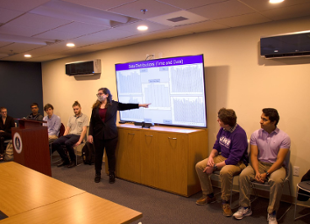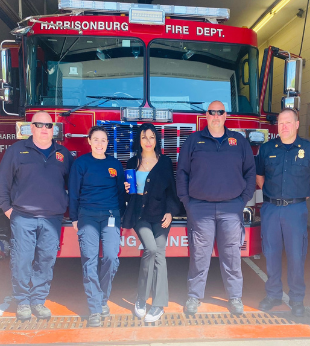Data to the Rescue
Partnering with the Harrisonburg Fire Department
Research
SUMMARY: A collaborative project between a JMU mathematics class and the Harrisonburg Fire Department (HFD) is providing students with an opportunity to apply classroom lessons to a real-world challenge in the local community.
A collaborative project between a JMU mathematics class and the Harrisonburg Fire Department (HFD) is providing students with an opportunity to apply classroom lessons to a real-world challenge in the local community. Students from Math 485: Mathematics for an Industrial Career worked throughout the spring semester to help HFD determine the optimal location for a new fire station based on the department's incident and response data. The JMU team, including students Max Aedo Espicto, Dominic Gammino, Michael Michniak, Chloe Powell, Ashray Shah, Colby Sherwood and Reggie Wilcox, joined the incident data with population, social vulnerability and property value data for the analysis. Under the guidance of Associate Professor of Applied Mathematics Hala Nelson and Professor of Applied Mathematics Roger Thelwell, the students used multiple approaches to determine possible locations for the station, including Monte Carlo simulations, machine learning techniques and geospatial analysis.

The JMU team presented their findings to local government leaders, including Fire Chief Matthew Tobia and Interim City Manager Ande Banks, on April 28 at Harrisonburg City Hall. The students discussed their goals of providing HFD with data and tools to reduce response times throughout the city and plan for a fifth fire station serving as many residents as possible. Various challenges associated with the project were also discussed, including language/jargon barriers between the student mathematicians and HFD personnel.

Harrisonburg Fire Chief Matthew Tobia shared his perspective on the JMU-HFD collaboration: “The work provided by the cohort of JMU students is the single most impactful body of work I have witnessed in my 35 years in public safety. Our communities are inextricably tied together, so leveraging the power of these students not only benefits the Fire Department, it more broadly impacts the city and the entire JMU family. Improving emergency services through a combination of community risk reduction and timely delivery of services are the cornerstones of public service. This type of work should be promoted in public safety agencies across the United States and we look forward to this continued partnership! We are deeply indebted to these brilliant minds.

Associate professor Nelson shared these thoughts about the project: “Our work with the Harrisonburg City Fire Department has been incredibly rewarding. It was a journey and we all learned a lot along the way. We watched the transformation of emergency incident data from big tables with hundreds of thousands of entries into a rich resource for valuable insights into making our city safer.
Learning how to do that in an efficient way, staying on task, communicating constantly with the Fire Department, understanding their language, and aligning our goals for the class with their priorities, has been an experience that we all will benefit from for a long time. This is real data of real people with real emergencies, and they are helping us save more lives and we are grateful for that. It was such a pleasure working with the Fire Department Chief Matthew Tobia, as well as Jordan Lambert and Chip Brown.

Professor Thelwell added: “This has been a fantastic project. It has been amazing to learn about the many strengths of the Harrisonburg Fire Department and the highly skilled men and women working to keep our city safe. Our students were incredible — from the sophomores to the seniors — and all were able to contribute in deep and meaningful ways to the success of the project. While this is the first time we've attempted a class like this, it will not be the last. Hala and I hope this course becomes a regular offering as an experiential capstone that serves our shared community and provides our students with a valuable and immediately applicable skillset.”
The faculty plan to continue this collaboration in future mathematics courses. A Preparation for Industrial Careers in Mathematical Sciences (PIC) grant and the JMU Department of Mathematics & Statistics provided funding for this project.
Photos courtesy of Brittany Higgs, Hala Nelson and Ben Delp
